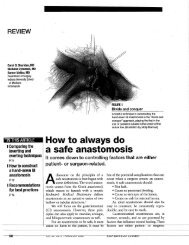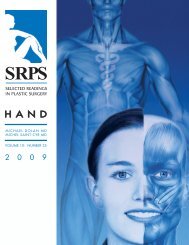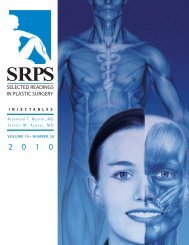Craniofacial Anomalies, Part 2 - Plastic Surgery Internal
Craniofacial Anomalies, Part 2 - Plastic Surgery Internal
Craniofacial Anomalies, Part 2 - Plastic Surgery Internal
You also want an ePaper? Increase the reach of your titles
YUMPU automatically turns print PDFs into web optimized ePapers that Google loves.
CENTRIC<br />
Corresponding Cranial<br />
Facial Clefts Extension of Facial Clefts<br />
No. 0 No. 14<br />
No. 1 No. 13<br />
No. 2 No. 12<br />
No. 3 No. 11<br />
ACENTRIC<br />
Corresponding Cranial<br />
Facial Clefts Extension of Facial Clefts<br />
No. 4 No. 10<br />
No. 5 No. 9<br />
No. 6<br />
No. 7<br />
No. 8<br />
Fig 2. Tessier’s classification of craniofacial clefts. Localization on<br />
the soft tissues (above) and skeleton (below). (Reprinted with<br />
permission from Tessier P: Anatomical classification of facial,<br />
cranio-facial, and latero-facial clefts. J Maxillofac Surg 4:69,<br />
1976; list from Whitaker LA, Pashayan H, and Reichman J: A<br />
proposed new classification of craniofacial anomalies. Cleft<br />
Palate J 18:161, 1981.)<br />
where skeletal cleft and soft-tissue cleft are not in the<br />
same position. Nevertheless, Tessier’s scheme remains<br />
in wide use today because it is relatively easy to learn<br />
for communicating with other clinicians. David et<br />
al 12 illustrate a complete series of these craniofacial<br />
clefts in 3D CT scans.<br />
SRPS Volume 10, Number 17, <strong>Part</strong> 2<br />
The tissue-deficiency disorders—arhinencephaly<br />
and holoprosencephaly—are secondary to failure of<br />
cleavage of the embryonic holoprosencephalon and<br />
of the normal longitudinal split into cerebral hemispheres.<br />
The tissue-excess deformities range from a<br />
slight midline notch of the upper lip to severe orbital<br />
hypertelorism.<br />
The holoprosencephaly malformation represents<br />
a hypoplastic No. 14 cleft in association with a tissue<br />
deficiency or a tissue excess. 13,14 Cohen and Sulik 15<br />
present a modern analytic review of the holoprosencephalic<br />
disorders. Central nervous system<br />
findings and craniofacial anatomy are discussed, syndromes<br />
and associated anomalies are updated, and<br />
the differential diagnosis is reviewed.<br />
Elias, Kawamoto, and Wilson 16 reviewed holoprosencephaly<br />
and midline facial anomalies in an<br />
attempt to redefine their classification and management.<br />
They note that true holoprosencephaly<br />
encompasses a series of midline defects of the brain<br />
and face, and in most cases is associated with severe<br />
malformations of the brain which are incompatible<br />
with life. At the other end of the spectrum are<br />
patients with midline facial defects and normal or<br />
near-normal brain development.<br />
Embryologic Classification<br />
Van der Meulen and coworkers13 tried to correlate<br />
clinical features of the disorders with embryologic<br />
events.<br />
Site of dysplasia/dysostosis and associated cleft:<br />
Frontosphenoidal = Tessier 9<br />
Frontal dysplasia = Tessier 10 and 11<br />
Interfrontal dysplasia = Tessier 0 and 14<br />
Treacher Collins = 6, 7, and 8 clefts<br />
Temporoauromandibular dysplasia = Hemifacial<br />
microsomia (craniofacial microsomia)<br />
Pathogenesis of Clefts<br />
There are two leading theories of facial cleft formation.<br />
The classic theory holds that clefts are caused<br />
by failure of fusion of the facial processes. 17-19 In this<br />
theory the medial face unites by fusion of the paired<br />
facial processes beneath the nasal pits. Epithelial<br />
contact is established and mesenchymal penetration<br />
completes the fusion of the lip and palate. If the<br />
sequence is disturbed, a cleft forms.<br />
3






